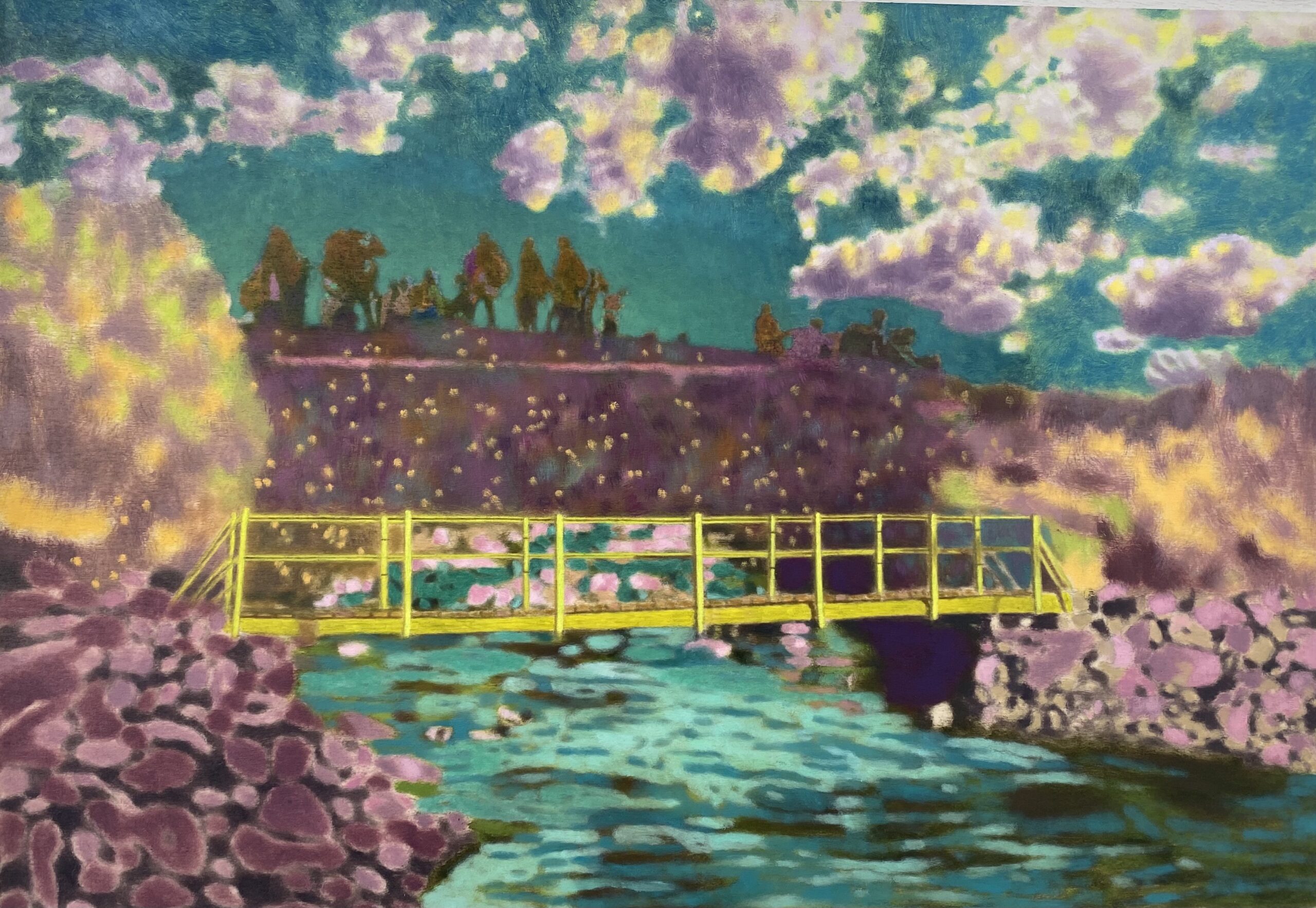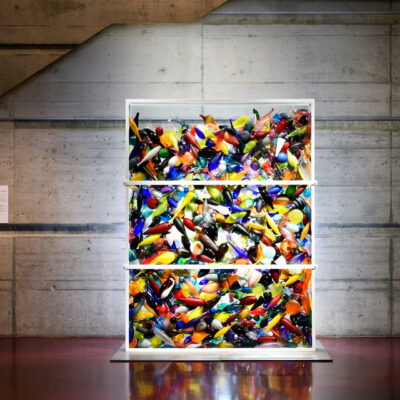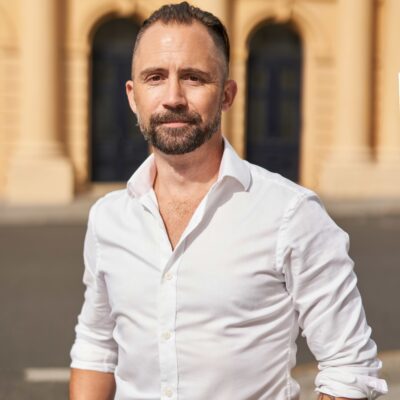Art Vista Magazine recently met with Galerie Untitled 1983’s Mighela Shama Lorenceau and artists Karolina Orzelek and Thomas Lesigne to discuss their artist’s residency and exhibition of the pieces created during this period of collaboration. Galerie Untitled 1983 was founded by Lorenceau, originally from Lausanne, upon her return from Paris two years ago where she had been immersed in the fashion world. Around the same time, she also created an artist’s residency program located in a studio / apartment near the gallery.
The latest artists to benefit from this arrangement are the rising young stars, Polish painter Karolina Orzelek and French artist Thomas Lesigne. The pieces from both artists in the show at Galerie Untitled 1983 are based upon the tension between experience and memory. Orzelek’s vibrantly-coloured oil on wood paintings blend intricately detailed imagery with atmospheric, expressionistic landscapes. She won the Prix Sisley Beaux-arts de Paris pour la Jeune Création in June 2020, and the influence of artists from the era of Sisley is evident in her work.
Thomas Lesigne’s watercolors are pensive and thoughtful, expressing recognisable yet atmospheric landscapes with a pale, quiet palette. The pieces alternate between more precise depictions of stones or wooden structures and soft-edged, foggier sections. They depict landscapes partially remembered, through the lens of nostalgia and passing time.
I spent a recent afternoon in the gallery and the studio with the artists and gallerist discussing the residency, collaboration, artistic influences, the NFT / digital art phenomena, and future plans.

Kristen Knupp (KK): What brought you to Geneva, what attracted you here, and what was the process of finding out about Galerie Untitled 1983 and the artist residency?
Karolina Orzelek (KO): Mighela contacted our art school, École Nationale Supérieure des Beaux-Arts de Paris, telling them about the residency and thinking that maybe some of the students would be interested, so we sent in an application and eventually we were accepted.
Mighela Shama Lorenceau (MSL): I think during three months we emailed and then set up a video call and talked. I always like to meet people before they come to at least see them. I loved their work so I straight away said “ok, let’s do it”, and then we signed the contract.
KO: We were also looking for quite a while for a location to work together, and to see what it would be like to make an exhibition together, so this was a perfect chance to do that.
KK: This is the first time that you have shown your work together. How do you think it has turned out?
KO: That is what you have to ask people who come to the exhibition!
Thomas Lesigne (TL): We can say that we had a lot of good feedback on the combination of our work, and how it works from people at the opening. It was more like an improvisation for us. We felt that we found a new flavour.
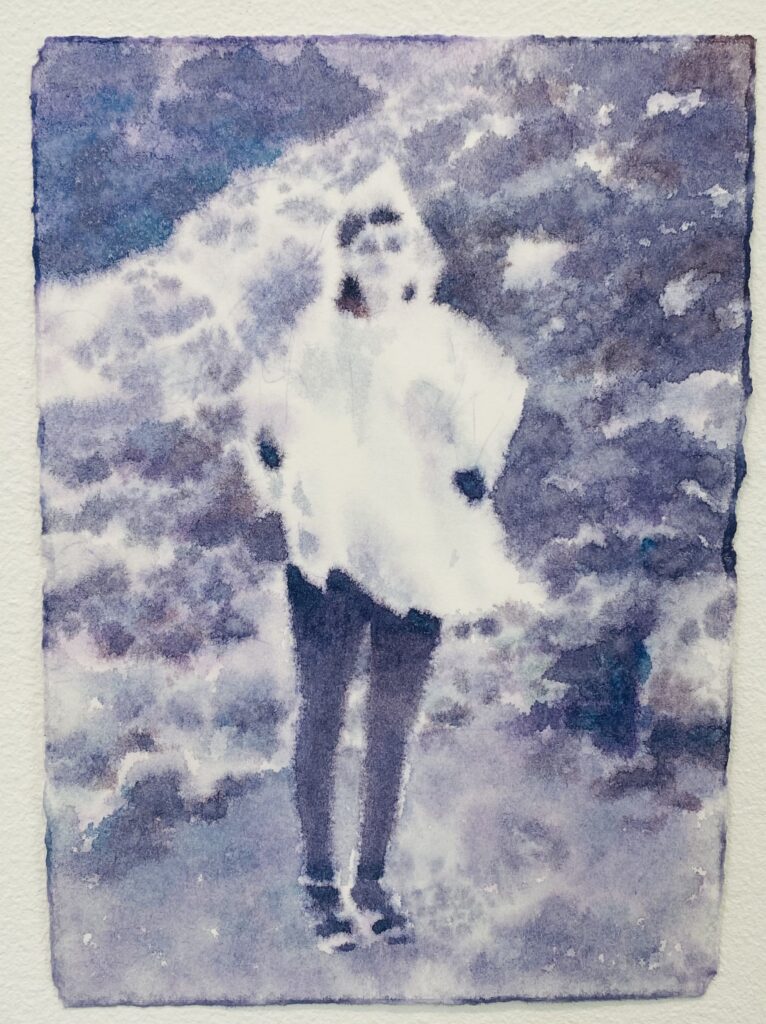
KO: We realize that our work is quite different but we felt that there was something interesting going on between the two. We weren’t sure if it was only in our heads. We hoped that visitors would see it as well.
MSL: At first you might think that their work would look nice together and it really does. They both work with memory and the subjects are very similar but the techniques and textures they use are very different.
KK: Did you look at each other’s work while you were creating it, and discuss it?
TL: While we were working we tried to focus on our work separately but tried to make something in common, while at the same time not changing the way we worked in Paris.
KO: I think it also influences you and gets inside your head, Thomas, I felt your watercolors here all the time because they influenced what I was doing and how I was thinking. I think it is the same for you?
TL: Yes. Yesterday after the show, we realised that we would do the same process and work together again.
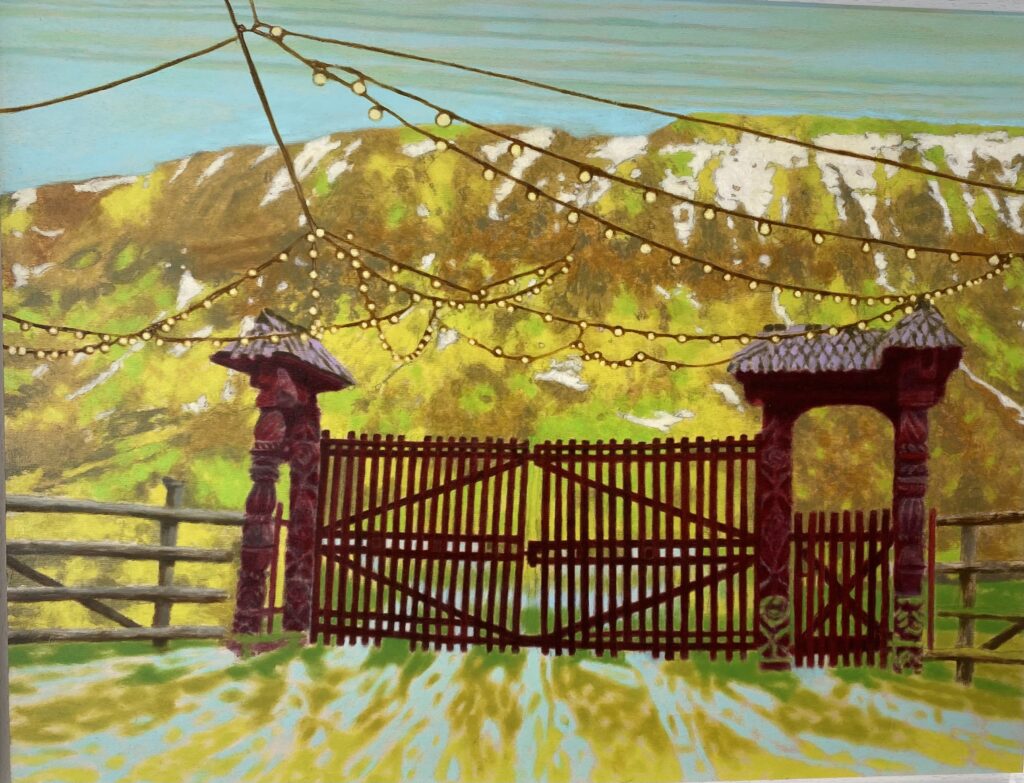
KK: Karolina, where did you get the idea to paint on wood?
KO: I first starting drawing on wood in 2015 because a professor told me that it would be interesting. It just felt natural to work with wood, and I liked it so much that I never went back to canvas. There are a lot of differences between wood and canvas. With wood, I first use a transparent layer, not a white layer as you do on canvas, so you can still see the texture of the wood. It is a hard support, unlike canvas, so you can apply your brushes in a different way, and it influences the color, and the way it feels. It is really different and it fit well with what I like to do in painting.
TL: I think once you told me that you like painting on wood because you get an object at the end.
KO: Yes, that is true. It is not something you can explain, it almost sounds mystical, but it is so direct and it is ready to go. It feels natural, and reassuring. I work with the veins in the wood in some pieces, and incorporate them into the landscape.
KK: Yes wood feels solid, it is durable and lasts over time. Almost the opposite of paper. Thomas, what kind of paper are you using in your work?
TL: I use rough paper, very rough so I can put on many laters of water. So I can manipulate it with force, and it will not break. There are some soft, smooth papers that I also like for detailed work, but when I am working with large paintings I like something more rough, with holes in the surface so it holds the paint. Also during the process I evaporate a lot of water on the paper so it gives a foggy appearance to the piece.

KK: Is the piece we see here in the studio from a particular location?
TL: This is from a black-sand beach in Iceland. It was beautiful. There was a bridge and then icebergs were coming out from a river, and then being pushed back into the beach because of the waves. I left out all the icebergs and just showed the rocks. The red dot is a signal ball for boats. The name of this piece is Digue (Dike) which is the barrier that protects the land from the waves of the sea.
MSL: This other one is also very interesting. I love the top right of the painting, the vegetation there. When Thomas arrived he said this is my painting, and he showed me a small box. How many sheets of paper is it made of, Thomas?
TL: 110 sheets. I changed my palette of color with each piece of paper, so I can break the image.
KK: It almost looks like a photograph that has been pieced together because some parts of it are very realistic, while other parts are more abstract.
TL: I like it when the image is moving and some parts are out of focus.
KK: How long did you take you to make this?
TL: It took one month of working almost every day. It has many layers so I would create one layer and then have to let it dry, and sometimes I used water to rework certain parts.

You can see something similar with David Hockney, with his mosaic photographs. He is 80 years old and I like the way he works with photography and videos.
MSL: He also does work on iPad and I like them.
KO: I think it works well because what he was doing before translates well into this medium.
MSL: Speaking of new technology Did you see the NFT digital artwork by Beeple that was sold for $69 million?
KO: Everyone is talking about it, and the gallery assistant explained it to us. It is the third most expensive artwork by a living artist ever sold. It is strange that this unknown artist’s work is already at Christie’s. I heard that with NFTs, the artist gets only 10% of the price.
MSL: I heard about NFTs recently while listening to a talk on the app Clubhouse, but I am no expert because it is a relatively new concept. It is interesting, especially for digital artists who wish to keep producing in their medium. But there is a massive amount of computing power needed, those computers need electricity…so there are environmental issues to keep in mind.
KK: It is amazing that this piece reached such a price. Rather than buying the artwork for its artistic merit, I think the buyer thought of the piece as part of history, because it is the beginning of the NFT artwork market.
KO: I think the piece is important because it was the first one. It also took 5000 days to make it.
KK: It reminds me a little of VR artwork.
MSL: VR is great! I had the pleasure to host Antoine Wagner’s show dedicated to it last summer. It was called “Umstellung” which translates to adaptation. The work was both immersive and participative. It made reference to the continually changing character of nature and enabled the spectator to escape and navigate through a re-created world. It was epic!
KO: I think the NFT work could be interesting, it is a tool so it can be useful for digital artist to have the chance to sell their work. But now there is such a crazy market and it seems to be speculation on the financial market. There are many different factors involved.

MSL: It opens a new door to people who are interested in NFT and who were not interested in art before.
KK: What about you Thomas, will you be producing digital artwork anytime soon?
TL: We have some friends in the art school who make videos and before it was hard for them to sell it. I think it will be good for them and will make more of a market for their art.
KO: For me it is a tool for the digital artist, so it is not relevant to my work. It is interesting but not my talent.
TL: We like manual things, touching the paper, and touching the wood. It is very important for us.
KK: What artists inspire your work? You mentioned David Hockney, is there anyone else?
TL: I really like Andrew Wyeth. I saw his foundation in Pennsylvania, and I discovered his work two years ago. I think we share the same melancholy feeling for the landscape and sometimes I crop the images that I take for my paintings in the same way that he does.

KO: There are so many different influences, I like the artists from 20th century, obviously post-impressionism and everything that followed that with a good relationship to color; Fauvism. Then I really like David Hockney’s work, and everyone talks to me about Peter Doig’s work which I really like as well. Then in the contemporary scene, there are so many artists. I really like the paintings of Senegalese artist Omar Ba, and also the American artist Maxfield Parrish. The light and the colors are so wonderful in some of them, and he had a special technique of layering the paint so that he could use bright colors, and he was very precise and controlled. At least he has been my inspiration for the last two weeks.
KK: So your inspiration changes quite a lot?
TL: There are some artists that we come back to again and again. Hockney is one of those, and also Monet. We went to see the Nymphéas at the Orangérie again. You get closer and you don’t understand the colors that he chose, and then you move back and it all makes sense. You have to step back to appreciate the painting.
KK: What are your plans now?
KO: We will go back to Paris, and I have a group show in April at Galerie Sabine Bayasli and Thomas will join it as well.
TL: I have a show at Galerie Sobering in Paris and then I am joining the group show, so we have some work to do.
The show at Galerie Untitled 1983 runs until April 15, 2021.
Credits for cover image: Karolina Orzelek, Moonlight Island, 2021. Oil on wood, framed. 72 x 50 cm. From Both Directions at Once, Galerie Untitled 1983. Photo: K. Knupp.
